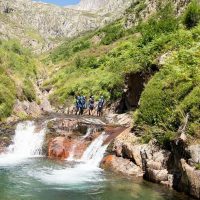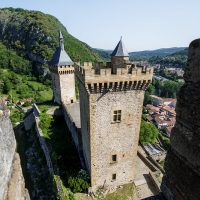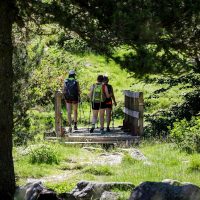Resolutely focused on tourism, the village of Bélesta ensures that its visitors are given the best possible welcome.
The historical past of Bélesta in the 1550th century revolves around the Lord of Audou, a fiery Huguenot captain from the Lévis de Mirepoix family. We can still admire its castle from below (private) in the center of the village and the ruins of its castle of Amont which housed its garrison on the other bank of the Hers. The parish church of Saint Blaise (1559-1318) is one with the castle below, its altarpiece and stained glass windows are worth a visit. The Val d'Amour chapel, already mentioned in 1559, was burned by the Lord of Audou in XNUMX. The frescoes of the Montalbanese artist Gaillard–Lala retrace its history and traditions, still alive with the famous Pentecost procession, where the reliquaries of Saint Blaise are taken up to the Val d'Amour. We enjoy a superb view both from the terrace of the Val d’Amour and that of the Château d’Amont. Based on a text by Anne–Marie Dambies.
►Château d’Amont: In Bélesta, take direction Fougax and Barrineuf. After the bridge, turn left. Access to the ruins of the castle is via a small path along the edge of the house on the right. Go up then at the intersection (barbed wire demarcates a wood), turn left.
►Saint Blaise Church: adjoining the Château de Bélesta.
►Chapelle du Val d’Amour: head towards Quillan, at the exit of the village, on the left on a hill.
At the exit of Bélesta:
►Intermittent fountain of Fontestorbes
►Fougax and Barrineuf road: Bélesta municipal forest made up of fir trees.
► The chasm of the ravens: at an altitude of 850 m, the chasm measures approximately 60 m by 30 m and is accessible thanks to a viewing platform for a safe visit. It is the abyss of both absorption and collapse. the total depth reaches approximately 110 m. In the heart of the Bélesta forest, this visit allows you to discover an exceptional natural environment.
►On the road to the Bélesta forest from the “castle” car park (old roadside building on your left with the basic layout of a natural car park on your right) take the path which leads to Cailhol d’ at the top and continue for approximately 1 km on the marked trail.
The crosses: the fifteen crosses which dot the commune of Bélesta, from the gates of Lavelanet (jubilee cross) to the heart of the forest, to the highest which dominates the village (Millet cross) all have a story which spans the centuries. Setting out to discover them is an opportunity for a walk, where the story of real-life anecdotes enlivens the landscape. Based on a text by Anne-Marie Dambies.
►Small collection presenting the crosses of the commune on sale at the Bélesta Town Hall.
☻PANORAMAS
The Millet cross: from the cross, an exceptional panorama is offered to you over Bélesta and the Hers valley.
►The access route to the cross is described in the topo – guide “Walks and hikes in Pays d’Olmes”.
Location
Cathar Pyrenees
Prices / Opening
Opening
| From January 01 to December 31, 2024 | |
| Monday | Open |
| Tuesday | Open |
| Wednesday | Open |
| Thursday | Open |
| Friday | Open |
| Saturday | Open |
| Sunday | Open |
Services
Services
- Pet Friendly










